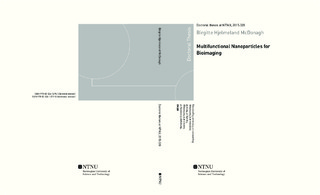| dc.contributor.author | McDonagh, Birgitte Hjelmeland | |
| dc.date.accessioned | 2016-01-11T08:34:25Z | |
| dc.date.available | 2016-01-11T08:34:25Z | |
| dc.date.issued | 2015 | |
| dc.identifier.isbn | 978-82-326-1297-0 | |
| dc.identifier.issn | 1503-8181 | |
| dc.identifier.uri | http://hdl.handle.net/11250/2373202 | |
| dc.description.abstract | Bioimaging is a broad term that covers all processes in which biological tissues are imaged. It
can range from single-cell visualization with fluorescence microscopy, to imaging of brain
structures in living human beings with magnetic resonance imaging. As such, the term is not
only interesting from a researcher’s point of view, but also to existing medical technologies.
Imaging living organisms is mainly based on existing tissue densities between blood,
brain, cartilage, and bone. However, in some cases these differences are not sufficient to
separate e.g pathological tissue from healthy tissue. In these instances, a contrast agent may
be administered to alter the contrast in the region of interest. Bioimaging of excised tissue
usually involve staining with a dye that binds specifically to a cellular organelle or membrane,
making it easier to separate intracellular structures from each other. Bioimaging of living and
excised tissue both involves an external probe that enhances the available information in the
image. Such probes must be synthesized from materials that are likely to improve the
acquisition of the image, and must also have few toxic side-effects.
Nanomaterials are in the size-range of molecules and proteins, and can potentially
traverse cellular membranes as well as being systemically administered. Nanoparticles are
described as multifunctional because they can show a range of optical responses, carry drugs
and vibrate in response to heat. The nanomaterials in this thesis were chosen based on their
plasmonic and magnetic properties, as well as their biocompatibility.
The aim of this thesis is twofold. The first aim is to fully characterize and synthesize
plasmonic nanomaterials of gold with biomineralization from proteins and from chemical
synthesis. The second aim is synthesis and characterization of magnetic nanomaterials of iron
and manganese. Characterization in this sense refers not only to physical description of the
nanoparticles or nanoconstructs, but involves describing how these nanomaterials interact
with biological tissues in vitro or in vivo, to assess their potential for bioimaging,
hyperthermia and drug delivery.
A plethora of methods have been used to characterize the nanomaterials synthesized in
this thesis. The nanomaterials of gold synthesized from proteins were described with a range
of optical techniques such as UV-visible and steady state spectroscopy, and time-correlated
single-photon counting. Size and shape was assessed with dynamic light scattering, scanning
transmission electron microscopy and high resolution transmission electron microscopy. The
surface charge was determined with zeta potential measurements. The crystalinity and
composition of nanoparticles were characterized with X-ray diffraction spectroscopy, and
surface composition was described with X-ray photoelectron spectroscopy. Interactions
between protein-stabilized nanomaterials and model membranes were described with
Langmuir-trough studies and atomic force microscopy. Magnetic nanomaterials were
characterized with magnetic resonance imaging and zero field cooling. Further, nanomaterials
were co-incubated with human cancer and/or rodent cells to assess their in vitro uptake or
cytotoxicity. The methods for in vitro assays involved fluorescence microscopy and a
cytotoxicity assay. Finally, ultramicrotome sectioning and scanning transmission electron
microscopy was used to describe cellular uptake as a function of time.
The main findings in the first part of this thesis are that fluorescent protein-gold
nanoconstructs show membrane interactions radically different from the native protein. We
also describe how protein-directed self-assembly of fluorescent gold nanoclusters and
plasmonic nanoparticles can be tuned to yield different optical gold nanostructures. In the
second part of this thesis, the main findings are size, - and shape-dependent uptake of novel plasmonic and magnetic nanoparticles in vitro, as well as cell actuation in a magnetic field.
The final part of this thesis culminates in synthesis of a nanoparticle system that can give dual
contrast in magnetic resonance imaging while at the same time release a drug. | nb_NO |
| dc.language.iso | eng | nb_NO |
| dc.publisher | NTNU | nb_NO |
| dc.relation.ispartofseries | Doctoral thesis at NTNU;2015:320 | |
| dc.relation.haspart | Paper 1:
McDonagh, Birgitte Hjelmeland; Volden, Sondre; Lystvet, Sina Maria; Singh, Gurvinder; Ese, Marit-Helen; Ryan, Joseph A.; Lindgren, Mikael; Sandvig, Axel; Sandvig, Ioanna; Glomm, Wilhelm.
Self-assembly and characterization of transferrin-gold nanoconstructs and their interaction with bio-interfaces. Nanoscale 2015 ;Volum 7.(17) s. 8062-8070
<a href="http://dx.doi.org/10.1039/c5nr01284h" target="_blank"> http://dx.doi.org/10.1039/c5nr01284h</a>
This journal is © The Royal Society of Chemistry 2015 | |
| dc.relation.haspart | Paper 2:
McDonagh, Birgitte Hjelmeland; Singh, Gurvinder; Bandyopadhyay, Sulalit; Lystvet, Sina Maria; Ryan, Joseph Anthony; Volden, Sondre; Kim, Eugene; Sandvig, Ioanna; Sandvig, Axel; Glomm, Wilhelm.
Controlling the self-assembly and optical properties of gold nanoclusters and gold nanoparticles biomineralized with bovine serum albumin. RSC Advances 2015 ;Volum 5.(122) s. 101101-101109
<a href="http://dx.doi.org/10.1039/c5ra23423a" target="_blank"> http://dx.doi.org/10.1039/c5ra23423a</a>
This journal is © The Royal Society of Chemistry 2015 | |
| dc.relation.haspart | Paper 3:
Bandyopadhyay, S., McDonagh, B.H., Singh, G., Sandvig, I., Sandvig, A., Glomm, W.R.
Makura-shaped gold nanostructures show high cytotoxicity in cancer cells. - Is not incuded due to copyright | |
| dc.relation.haspart | Paper 4:
McDonagh, B.H., Singh, G., Peddis, D., Bandyopadhyay, S., Sandvig, I., Sandvig,
A., Glomm, W.R. Pentatwinned iron oxide nanoparticles as glioblastoma-astrocytoma
cell actuators. - Is not included due to copyright | |
| dc.relation.haspart | Paper 5:
McDonagh, Birgitte Hjelmeland; Singh, Gurvinder; Hak, Sjoerd; Bandyopadhyay, Sulalit; Augestad, Ingrid Lovise; Peddis, Davide; Sandvig, Ioanna; Sandvig, Axel; Glomm, Wilhelm.
L-DOPA-Coated Manganese Oxide Nanoparticles as Dual MRI Contrast Agents and Drug-Delivery Vehicles. Small 2015
- This is the pre-peer reviewed version of the article which was first published online: 30 November 2015 - in final form Volume 12, Issue 3
January 20, 2016
Pages 301–306
<a href="http://dx.doi.org/10.1002/smll.201502545" target="_blank"> http://dx.doi.org/10.1002/smll.201502545</a>
© WILEY-VCH Verlag GmbH & Co. KGaA, Weinheim | |
| dc.title | Multifunctional Nanoparticles for Bioimaging | nb_NO |
| dc.type | Doctoral thesis | nb_NO |
| dc.subject.nsi | VDP::Technology: 500::Chemical engineering: 560 | nb_NO |

